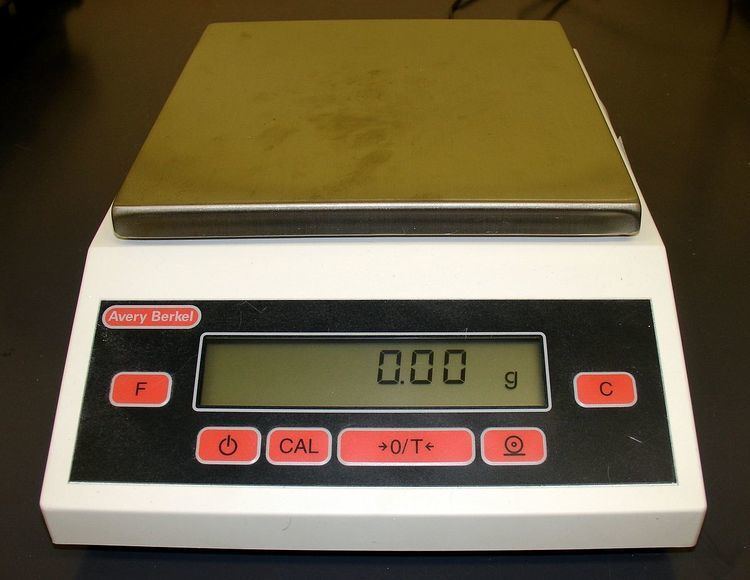 | ||
Baker's percentage is a baker's notation method indicating the flour-relative proportion of an ingredient used when making breads, cakes, muffins, and other pastries. It is also referred to as baker's math, or otherwise contextually indicated by a phrase such as based on flour weight. It is sometimes called formula percentage, a phrase that refers to the sum of a set of bakers' percentages. Baker's percentage expresses each ingredient in parts per hundred as a ratio of the ingredient's mass to the total flour's mass (that is, the unit mass):
Contents
- Baker percentages
- Conversions
- Using baker percentages
- Creating bakers percentages
- Weights and densities
- Drawbacks
- Advantages
- Common Formulations
- Dough hydration
- Errata
- References
For example, in a recipe that calls for 10 pounds of flour and 5 pounds of water, the corresponding baker's percentages are 100% for the flour and 50% for the water. Because these percentages are stated with respect to the mass of flour rather than with respect to the mass of all ingredients, the total sum of these percentages always exceeds 100%.
Flour-based recipes are more precisely conceived as baker's percentages, and more accurately measured using mass instead of volume. The uncertainty in using volume measurements follows from the fact that flour settles in storage and therefore does not have a constant density.
Baker percentages
A yeast-dough formula could call for the following list of ingredients, presented as a series of baker's percentages:
Conversions
There are several common conversions that are used with baker's percentages. Converting baker's percentages to ingredient weights is one. Converting known ingredient weights to baker percentages is another. Conversion to true percentages, or based on total weight, is helpful to calculate unknown ingredient weights from a desired total or formula weight.
Using baker percentages
To derive the ingredient weights when any weight of flour Wf is chosen:
In the example below, 2 lb and 10 kg of flour weights have been calculated. Depending on the desired weight unit, only one of the following four weight columns is used:
Creating baker's percentages
The baker has determined how much a recipe's ingredients weigh, and uses uniform decimal weight units. All ingredient weights are divided by the flour weight to obtain a ratio, then the ratio is multiplied by 100% to yield the baker's percentage for that ingredient:
Due to the canceling of uniform weight units, the baker may employ any desired system of measurement (metric or avoirdupois, etc.) when using a baker's percentage to determine an ingredient's weight. Generally, the baker finds it easiest to use the system of measurement that is present on the available tools.
The total or sum of the baker's percentages is called the formula percentage. The sum of the ingredient masses is called the formula mass (or formula "weight"). Here are some interesting calculations:
Weights and densities
The use of customary U.S. units can sometimes be awkward and the metric system makes these conversions simpler. In the metric system, there are only a small number of basic measures of relevance to cooking: the gram (g) for weight, the liter (L) for volume, the meter (m) for length, and degrees Celsius (°C) for temperature; multiples and sub-multiples are indicated by prefixes, two commonly used metric cooking prefixes are milli- (m-) and kilo- (k-). Intra-metric conversions involve moving the decimal point.
Common avoirdupois and metric weight equivalences:
1 pound (lb) = 16 ounces (oz)1 kilogram (kg) = 1,000 grams (g) = 2.20462262 lb1 lb = 453.59237 g = 0.45359237 kg1 oz = 28.3495231 g.In four different English-language countries of recipe and measuring-utensil markets, approximate cup volumes range from 236.59 to 284.1 milliliters (mL). Adaptation of volumetric recipes can be made with density approximations:
Due to volume and density ambiguities, a different approach involves volumetrically measuring the ingredients, then using scales or balances of appropriate accuracy and error ranges to weigh them, and recording the results. With this method, occasionally an error or outlier of some kind occurs.
Drawbacks
Baker's percentages do not accurately reflect the impact of the amount of gluten-forming proteins in the flour on the final product and therefore may need to be adjusted from country to country, or even miller to miller, depending on definitions of terms like "bread flour" and actual protein content. Manipulation of known flour-protein levels can be calculated with a Pearson square.
In home baking, the amounts of ingredients such as salt or yeast expressed by mass may be too small to measure accurately on the scales used by most home cooks. For these ingredients, it may be easier to express quantities by volume, based on standard densities. For this reason, many breadmaking books that are targeted to home bakers provide both percentages and volumes for common batch sizes.
Besides the need for appropriate readability scales, a kitchen calculator is helpful when working directly from baker's percentages.
Advantages
Baker's percentages enable the user to:
Common Formulations
Common formulations for bread include 100% flour, 60% water/liquid, 1% yeast, 2% salt and 1% oil, lard or butter.
Dough hydration
In a recipe, the baker's percentage for water is referred to as the "hydration"; it is indicative of the stickiness of the dough and the "crumb" of the bread. Lower hydration rates (e.g., 50–57%) are typical for bagels and pretzels, and medium hydration levels (58–65%) are typical for breads and rolls. Higher hydration levels are used to produce more and larger holes, as is common in artisan breads such as baguettes or ciabatta. Doughs are also often classified by the terms stiff, firm, soft, and slack. Batters are more liquid doughs. Muffins are a type of drop batter while pancakes are a type of pour batter.
